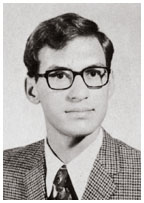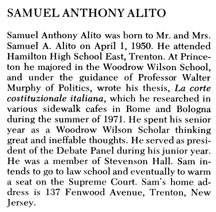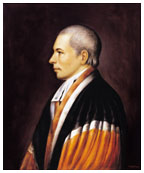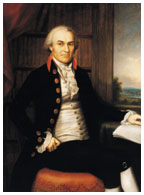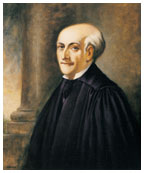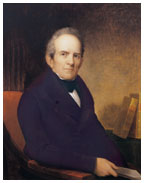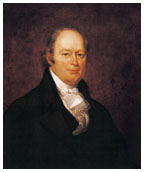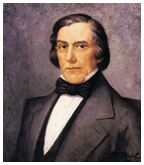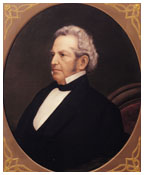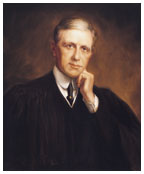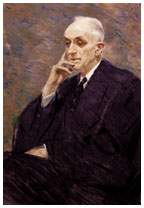
|
March 8, 2006: Features
Alito’s now-famous 1972 Nassau Herald entry that noted his intention to become a Supreme Court justice. |

A Tiger on the court
Sam Alito ’72 at Princeton
By Mark F. Bernstein ’83
In the spring of 1971, Samuel A. Alito Jr. ’72, now the newest Supreme Court associate justice but then a sharp Princeton junior, took a field trip to Washington, D.C., with the Whig-Cliosophic Society. Dubbed “Project Update,” the trip offered undergraduates the chance to rub elbows with national policy-makers.
The group had failed to arrange meetings with Justices Thurgood Marshall and Hugo Black. Still, they succeeded in meeting Justice John Marshall Harlan II ’20, whose resistance to several expansive Warren Court rulings had earned him the nickname the “great dissenter.” Almost alone among the Princetonians that day, Alito was familiar with Harlan’s rulings. And he was the only student, recalls trip organizer George Pieler ’73, to show up on time.
Young Alito drew out the justice by asking him to elaborate upon his commitment to a theory of judicial interpretation known as “the law of the case,” says Pieler, now a senior fellow at the Institute for Policy Innovation, a conservative think tank in Lewisville, Texas. That was a theory of judicial restraint that held that a judge’s primary duty is to tailor his rulings as closely as possible to the particular facts of each case, and to eschew sweeping constitutional pronouncements unless they were unavoidably called for. The justice responded enthusiastically to the undergraduate’s question, stressing — as Pieler recalled — “the duty of the judge to decide the case at hand, not promulgate new rules of conduct for society as a whole.”
Years later, Alito would refer to his admiration for Harlan as he described his own intellectual development at Princeton — less in terms of what he absorbed, but of what he rejected. “In college,” Alito wrote in a 1985 application for a promotion in the Justice Department, “I developed a deep interest in constitutional law, motivated in large part by disagreement with Warren Court decisions, particularly in the areas of criminal procedure and the Establishment Clause, and reapportionment.” It was Harlan who had dissented in Miranda v. Arizona (1966), which announced the requirement that suspects be read their rights upon arrest, as well in Reynolds v. Sims (1964), setting forth the requirement of “one man, one vote” in legislative apportionment. Harlan wrote in the latter case, “The Constitution is not a panacea for every blot upon the public welfare, nor should this court, ordained as a judicial body, be thought of as a general haven of reform movements.”
Like his judicial hero, Alito — who was not available to comment for this article — was a conservative during an era when more liberal viewpoints prevailed. If Alito cast himself at his confirmation hearings in January as something of an unflappable outsider during his Princeton years, friends say, that’s because he was one. Raised in a middle-class, Catholic family, Alito had grown up in Hamilton Township, N.J., a working-class suburb of Trenton. During their college years, says Mark Dwyer ’72, Alito’s friend at Princeton and roommate at Yale Law School, “those of us who came from places like Trenton and were Catholics did not fit into the Princeton mold. We hadn’t gone to prep school. Our parents weren’t part of the wealthy Eastern Establishment. The prevailing mood on campus was in flux, but it wasn’t entirely disconnected from the F. Scott Fitzgerald [’17] mold.” Though students such as Alito were not ostracized, Dwyer explains, they were plainly outsiders on a campus dominated by protesters as well as preppies, and they felt it.
Though his was not quite a Horatio Alger story, Alito was a second-generation Italian-American whose parents recognized the importance of education: Both worked as teachers, and Alito’s father went on to serve for almost 30 years as director of New Jersey’s nonpartisan Office of Legislative Services. David Grais ’73, a former roommate, says Alito was deeply influenced by his father, and drew a great distinction between politics and public service. “He always wanted to [be in public service] by using his head,” Grais says.
Alito was a sophomore during the turbulent spring of 1970 — the spring when students wearing war paint harassed Interior Secretary Walter Hickel as he spoke on a campus stage, when 190 students turned in their draft cards at a “Rite of Protest” in the University Chapel, and more than 4,000 massed in Jadwin Gymnasium for a seven-hour meeting after the announcement of American bombing in Cambodia. Whether Alito witnessed any of these events, his Princeton friends can’t recall. But they remember one thing: When students boycotted the last day of classes, and faculty members agreed to waive exams and other end-of-term activities, Alito was annoyed.
“Sam’s concern was, what about people who just want to go ahead and do what they’re doing under the current schedule?” recalls Richard Clifton ’72, now a judge on the U.S. Court of Appeals in Hawaii. “I remember him thinking that students who are here to be students should be allowed to be students.” Ken Burns ’72, who roomed with Alito in Joline Hall during their senior year, remembers his friend’s disappointment this way: “I think it pained Sam to see so much destruction and impairment of teaching, which is why we were there.”
While other students protested the presence of ROTC on campus, Alito signed up to serve. Friends say it was not a political statement, but an attempt to make the best of a tough situation: He had drawn a low draft number, and hoped to graduate and then enter the Army as an officer rather than wait to be inducted as a private. Not long after he joined, on the morning of May 2, two students firebombed ROTC offices at the Princeton Armory. Less than a month later, the trustees approved a faculty proposal to terminate ROTC altogether, and the cadets decamped to Trenton State College. Because of concerns for their safety, says Andrew Napolitano ’72, Alito’s ROTC commander at the time and now a judicial analyst at FOX News, students were instructed by the Army not to wear their uniforms around the Princeton campus.
The events stung. “I thought [the decision to expel ROTC] was very wrong,” Alito told the senators at his hearings. “I had a lot of friends who were against the war in Vietnam, and I respected their opinions, but I didn’t think that it was right to oppose the military for that reason. ... And the attitude seemed to be that the military was the bad institution, and that Princeton was too good for the military, and that Princeton would somehow be sullied if people in uniform were walking around the campus, that the courses didn’t merit getting credit, that the instructors shouldn’t be viewed as part of the faculty.” (Alito, who went on to serve four months on active duty following his graduation from Yale Law School, remained an inactive member of the reserves until his honorable discharge, with the rank of captain, in 1980).
Jeffrey Laurenti *74, who debated against Alito in high school and had a similar upbringing, ended up at Harvard, but he could identify with the sense of resentment working-class students felt toward radical students at elite universities. “These were kids who can play at revolution today, but in 10 years, family connections will assure that you can assume your ‘rightful position’ in society. That was something folks from our background had in our collective subconsciousness.” For students such as Alito, Laurenti believes, the chance to get an education at a place such as Princeton — even, it seems, the chance to take exams — was too valuable to be spent playing on the neo-gothic barricades.
Thirty-five years later, Alito seems to remember his undergraduate years with some bitterness. “It was a time of turmoil at colleges and universities,” he told the Senate Judiciary Committee. “And I saw some very smart people and very privileged people behaving irresponsibly. And I couldn’t help making a contrast between some of the worst of what I saw on the campus and the good sense and the decency of the people back in my own community.”
Nevertheless, if Alito seethed at the time, he kept it to himself. Classmates uniformly describe him as “calm” or “low-key.” Referring to the grilling Alito faced during his confirmation hearings, Napolitano says, “When [Delaware Sen.] Joe Biden was going on, friends asked me, ‘Do you think Sam will lose his temper?’ And I replied, ‘He doesn’t have a temper to lose.’”
As an undergraduate majoring in the Woodrow Wilson School and interested in the law, Alito drew inspiration not only from Harlan, but from the writings of constitutional scholar Alexander Bickel, whose work, Alito once wrote, inspired him to go to law school. Like Harlan, Bickel was hard to pin down politically: An editor of The New Republic and attorney for The New York Times in the Pentagon Papers case, for example, he also argued that the Supreme Court had overstepped its constitutional bounds in Brown v. Board of Education and defended Richard Nixon for firing Watergate special prosecutor Archibald Cox. Like Harlan, though, Bickel insisted that judges know their proper place in the constitutional system, and that it was the role of the judiciary “to ease rather than finally resolve” tensions, to “invent compromises and accommodations before declaring firm and unambiguous principles.”
Alito’s love of debating continued at Princeton, and he eventually became president of the debate panel. Patrick O’Connell ’74 recalls the group’s Sunday-night meetings in the dingy basement of Murray-Dodge Hall. “Mostly, we told jokes,” he says. Alito was quick on his feet and could leaven his remarks with flashes of humor, but Dwyer recalls that “Sam was not a one-liner, crack-up-the-room guy. He was a marshal-the-facts guy.”
In 1971, Alito, Grais, and O’Connell traveled to Northampton, Mass., for a debate against, as the Daily Princetonian put it, “a pipe-smoking team from Smith” (which included Alito’s sister, Rosemary) on the topic, “You’ve come a long way, baby, but not far enough.” According to the Princeton Style, a debate-panel journal, “Dave, Sam, and Pat, arguing affirmatively, managed with amazing ease to convince their audience that women’s lib was good.” In one of the rare recorded examples of Alito’s collegiate wit, he explained coeducation at Princeton by observing that, “With the price of imports rising and the quality of goods declining, University officials thought it time for Princeton to foster its own infant industry.”
In another debate that winter at the Royal Military College in Kingston, Ontario, Alito and Grais lost to a team from McGill University on topics that included, “Resolved: That war is too serious a matter to be left to the military mind” and “Resolved: That one-half of the nation is mad and the other is not very sound.” There is no record of what positions Alito took. But Princeton Style did record what happened on the drive home, when the students were stopped at the Canadian border and admitted having bottles of port in the trunk: “The customs agent ... carefully examined our port before returning it to us and telling us we had crummy taste. But what would you have expected for something Sam picked out?” In still another debate, on the resolution, “Should Vice President [Spiro] Agnew be censured for his speeches on the 1970 election campaign?” (a reference to a series of speeches Agnew had given impugning the patriotism of liberals and opponents of the Vietnam War), Alito argued the negative and won $100.
Alito did not join one of the traditional eating clubs, taking his meals instead at Stevenson Hall, which had recently been formed by the University as an alternative to the bicker clubs. “At that time, Stevenson attracted a pretty vibrant group of people,” recalls Grais. “It was more intellectually inclined than the usual clubs. We were a pretty egg-heady bunch.”
“We didn’t drink much, by the standards of Prospect Street,” adds Burns, though in an affectation that might have earned him hoots of derision in down-to-earth Hamilton Township, Alito apparently had somewhat sophisticated (for an undergraduate) tastes in alcohol, shunning beer in favor of an occasional Scotch, sherry, or whiskey sour. Musical tastes in their dorm room ran heavily toward classical. On weekends, Alito often would go home; friends say he regularly attended Mass. For relaxation, Burns says, “we talked with each other.”
Usually, Dwyer says, students like Alito and himself — serious, diligent, small-C conservatives — filled their time at Princeton by studying. Academically, Alito excelled, graduating Phi Beta Kappa. Most evenings, he could be found squirreled away in a carrel at the Woodrow Wilson School. Burns recalls Alito as reticent in class, but adds that he “had a sharp wit and could see through something pretentious or sophistry and slice through it in as few words as possible.” Though quiet, Alito was ambitious, providing the now-famous Nassau Herald quote that “Sam intends to go to law school and eventually to warm a seat on the Supreme Court.”
As a senior, Alito chaired a Wilson School task force on governmental privacy. Supervising a group of as many as 20 other students, Alito probably “played some kind of coaching role” for younger members, in the recollection of former professor George Forgie. Alito summarized the group’s recommendations, which included such provocative and seemingly un-conservative ideas as creating a federal privacy ombudsman, setting up a joint congressional committee on domestic surveillance by the federal government, abolishing state anti-sodomy laws, and forbidding discrimination against homosexuals. However, Alito’s seven-page overview is in the nature of an executive summary; others cautioned that the views expressed did not necessarily reflect Alito’s.
The faculty member who most influenced Alito certainly was Walter F. Murphy, then the McCormick Professor of Jurisprudence, whose course on constitutional interpretation Napolitano describes as “the closest thing to a law school-level” course at Princeton. With Murphy as his adviser, Alito wrote his senior thesis on the Italian Constitutional Court, spending part of the summer after his junior year doing research for it in Rome and Bologna. The thesis was meticulously researched, dispassionately written, and, for anyone who does not bring to it a deep interest in the Italian legal system, well-nigh unreadable in its density. Alito’s martini-dry wit seems to have been saved for his friends. “After 30-plus years I don’t recall specific sayings,” Murphy wrote in an e-mail. “Nor do I recall Sam’s engaging in humor.”
Friends and faculty don’t recall Alito actively engaging in any of the almost nonstop political debates at the time, either. Although Alito has since claimed that he supported Barry Goldwater’s 1964 presidential campaign and was a regular reader of William F. Buckley’s National Review, he seems to have kept his conservativism largely to himself. “Sam was not a joiner,” says Grais. “He was highly aware [politically], but he was not assertive or strident.”
“He was conservative, but he was never a partisan Republican,” says Frederick Larson ’73, a friend in the Woodrow Wilson School. O’Connell, who belonged to a conservative student group, Undergraduates for a Stable America, says Alito was never a member and that “I never heard of him being connected with any of the political movements on campus” at the time.
And that, in fact, may explain the controversy concerning Alito’s membership in the now-defunct, conservative group Concerned Alumni of Princeton, which he claimed in his 1985 Justice Department application and which consumed a good portion of his confirmation hearings. Alito testified that he was not actively involved in the group, which was borne out by a review of CAP records in the Library of Congress as well as the recollection of those who were members. “I never knew Sam was a conservative until he showed up in the Reagan administration,” says Napolitano, a former CAP president. Because CAP did not keep a membership list as such, he suspects that Alito joined by buying a subscription to the group’s magazine, Prospect, during one of its periodic mass solicitations of alumni, and that he touted his membership on his 1985 job application in order to boost his otherwise meager credentials as a card-carrying Reaganite.
“There were two types of conservatives at Princeton,” Napolitano says: “those who were conservatives before Ronald Reagan and those who were conservatives after. If you told [then-Attorney General] Ed Meese that you were a member of CAP, that told him you weren’t a new arrival [to the conservative moment]. It was a way of saying, ‘I’m the real thing.’”
In this case, at least, Alito, the natural outsider, seems to have decided
to play an insider. ![]()
Mark F. Bernstein ’84 is PAW’s senior writer.
In the court’s service
With the confirmation of Justice Samuel Alito ’72, Princeton can claim 10 alumni on the roster of 110 justices who have served on the nation’s highest court, including several influential figures from the court’s formative years. The following sketches remember Alito’s Princeton predecessors.
By B.T.
(Images: Collection of the Supreme Court of the United States)
|
|
William Paterson 1763 Best known for helping to shape the legislative branch at the Constitutional Convention, Paterson later made his mark on the judiciary, participating in the landmark Marbury v. Madison case, which established the court’s power to declare laws unconstitutional. (artist: Casimir Gregory Stapko) |
|
|
Oliver Ellsworth 1766 Ellsworth, Princeton’s lone chief justice, made few lasting contributions in his four years on the high court, but at least he helped cut down on paperwork. He pioneered the use of consensus opinions, rather than having each justice write his own. (artist: William Wheeler (after Ralph Earle)) |
|
H. Brockholst Livingston 1774 Although one biographer wrote that Livingston “never left a mark” on the court, the justice’s pre-court career was a remarkable tale of survival. He fought in the Continental Army, survived a stint as a prisoner of war, ducked an assassination attempt in 1785, and killed a rival in a 1798 duel. (artist: Casimir Gregory Stapko)
|
|
Smith Thompson 1788 Preoccupied with political aspirations early in his career, Thompson eventually contributed to several important decisions, but according to biographer Donald M. Roper, he spent his career “in the shadow of legal giants” such as John Marshall. (artist: Ashur B. Durand) |
|
William Johnson Jr. 1790 Johnson’s independence earned him historical distinction as the “first dissenter,” and in many cases on the Marshall court, he was the only one. He wrote 34 minority opinions, far more than his contemporaries on the court. (artist: Unknown)
|
|
Peter V. Daniel 1805 A gifted student, Daniel entered Princeton with the junior class, but he withdrew after less than a year on campus. At home in Virginia, he prepared for a law career under the tutelage of his father-in-law, Edmund Randolph, the first U.S. attorney general. (artist: Earl Clarke Daniel) |
|
James Moore Wayne 1808 Wayne, Princeton’s longest-serving justice, concurred in the court’s infamous Dred Scott decision, supporting slavery. But his devotion to country outweighed loyalty to his native Georgia: When the Southern states seceded, Wayne remained on the court. (artist: John Maier) |
|
Mahlon Pitney 1879 Pitney studied law under his father, a prominent attorney. When the University secretary inquired about his degree in 1906, the then-New Jersey Supreme Court justice replied, “Dear Sir, I attended no law school and have no law degree. Yours very truly, Mahlon Pitney ’79.” (artist: Adrian Lamb) |
|
John Marshall Harlan ’20 The grandson of a Supreme Court justice of the same name, Harlan was a key conservative voice on the Warren court. In his PAW memorial, classmates recalled their former class president’s “forthright character, his innate friendliness, and his superior intellect.” (artist: Gardner Cox) |
![]()

